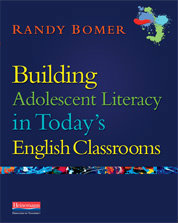Literacy Strategies that Work
Building Adolescent Literacy in Today‘s English Classroom
By Randy Bomer
(Heinemann, 2011 – Learn more)
“What’s wrong with kids today? They won’t listen or sit still. I have to just about stand on my head to get them to listen. What can I do to get them to read? Kids today are not like what I was when I grew up!”
Every time that I hear that, I think of the movie, Bye, Bye Birdie when Paul Lynde asks, “What’s the matter with kids today?”
Kids today are not like the kid you were when you grew up. And they shouldn‘t be. Life has changed and to be an effective educator, you must be an agent of change. According to Randy Bomer, author of Building Adolescent Literacy in Today‘s English Classroom, “Today’s English classrooms should not look like the English classes of the 1940s or even the 1980s. Student now engage in dozens of literacy activities that were unavailable just a generation ago.” These words resonated in my mind as I read this insightful text.

What’s inside the book
At first, I had high hopes that this would be a book I could read in a week or two and immediately apply in my classroom. The application was the easier part — the quick skimming for information was the harder part. As I struggled with reading the book, I realized it was because there was so much to absorb. The “light bulb moment” came when I realized what was needed! I needed to apply some of the reading strategies that I was teaching my students: chunk the information, reread and rephrase, and use Post Its to jot down questions you have and track the answers. Simple, but effective, and it worked.
Bomer’s book, based on research, experience, and best practices in literacy, follows the Readers and Writers Workshop model. He makes frequent references to research based studies, and the anecdotal stories he includes help to connect the book with the reader. However, for the most part, his writing style is very analytical and the information seems to jump around. For example, he stresses the importance of examining our reading lives in Chapter One, but then refers the reader to another section of the book to explain the strategy. The reader is left wondering whether to continue reading or skip to the referred section.
Bomer’s passion for literacy for all students is evident throughout. He addresses the need to provide literacy lessons that that are globally and technologically significant. According to the NCTE, as society and technology change, so does our literacy. Quoting the NCTE Definition of New Literacies, 21st-century readers and writers need to:
- Develop proficiency with the tools of technology;
- Build intentional cross-cultural connections and relationships with others so to pose and solve problems collaboratively and strengthen independent thought;
- Design and share information for global communities to meet a variety of purposes;
- Manage, analyze, and synthesize multiple streams of simultaneous information;
- Create, critique, analyze and evaluate multimedia texts;
- Attend to the ethical responsibilities required by these complex environments.
I found his chapter “Making More of Grammar” especially interesting and thought provoking. Gone are the days of worksheets and standardizing grammar with copying exercises out of a book. Bomer stresses the need to be more aware of embracing language diversity such as code-switching and dialects, and exploring the craft of writing. He embraces this philosophy throughout the book, with sidebars on how to apply the strategies with ELL students and make the lessons technologically relevant.
A resource worth the effort
This book is a great resource. However, I felt that the reader would benefit from reading the book in a book club or as part of a college course. Reflective sidebar sections ask the reader to pause and consider the practices they are currently using. The reader with a timeline in mind, hoping to read the book quickly and practice the strategies and skills, might ignore these sections, hoping to get to “the end” and skip the reflective piece. That’s a mistake. The sidebars are extremely important — not just “window dressing.” Part of being an effective teacher is reflecting on current practices. If something’s broke, we need to fix it.
Admittedly, Building Adolescent Literacy in Today‘s English Classroom is not a quick read. But it is a thought provoking book that may change the way you currently teach literacy or reaffirm your present teaching style. Even before I finished reading the book, I was sharing insights, sidebar reflections, and strategies with my colleagues. You will enjoy reading it independently or as part of a group study.
Linda Biondi is a fifth grade teacher at Pond Road Middle School in Robbinsville, New Jersey. She has been the recipient of several educational grants that infuse a literacy enriched curriculum along with an understanding of individual learning styles to help students understand bias and patterns of discrimination. She is the author of the Education World article “Dimes for Charity,” about a positive behavior program that centers on developing students’ social action and awareness.





























